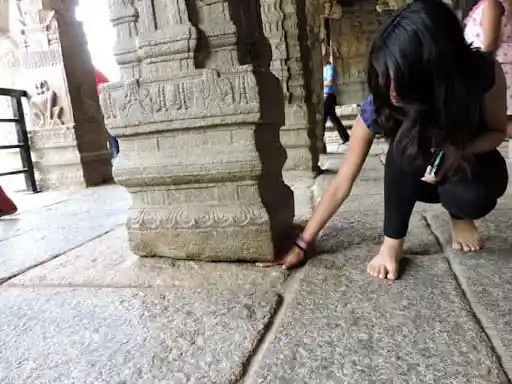The Hanging Mystery Of Lepakshi
Pillars support houses and buildings. Attached to the ground, these pillars not only become the center of attraction in most homes but also firmly support the ceilings. But picture a post that is suspended from the ceiling and doesn't touch the earth. People might get confused about whether the pillar supports the roof or the ceiling supports the pillar. Such hanging pillars have become a symbol of fascination and attraction in Lepakshi Temple.

The hanging pillar in Lepakshi, Image source- Atlas Obscura
Our country is filled with many gorgeous sculptures, from extravagantly decorated temples to intricately painted shops. With every step, we find amusement and colors filled to the brim. There are many fascinating stories surrounding these architectural beauties. Some explain these mysteries through science and logic, while others prefer to keep the stories mythological. Whatever the approach, we continue to come across these architectural marvels and are awed by their intelligent engineering and legendary stories.
Today, we will travel to one such location that continues to be famous for both spiritual and architectural reasons. Thousands of tourists flock to a small town called Lepakshi to see an architectural wonder named Veerabhadra Temple. This temple holds a lot of secrets, including a pillar that defies gravity. Let’s learn about the secrets that this beautiful temple has.
The Veerabhadra Temple was built in the year 1530 by two brothers named Virupanna Nayaka and Viranna.
Under the mighty rule of King Achutaraya, both the brothers were given leadership positions. This power vested in their hands allowed them to build one of the most magnificent temples of the era. This temple was built for Lord Shiva, one of the most revered deities of Hinduism.
Apart from this historical perspective, Lepakshi also has a mythological origin. It is said that when Jatayu fell to the ground after fighting with Ravan, it was in this village that Ram spotted the bird. Upon seeing the bird in such a condition, Ram said, “Le Pakshi,” which means “Rise, Bird” in Telugu. That’s how the village got its name.
The temple is in itself an architectural marvel. Every corner of the temple is filled with intricate structures, eugenically, historically, and archaeologically symbolic. elements. The temple consists of three chambers: the assembly hall, antechamber, and inner sanctum. When one enters the sanctum sanctorum, one can see plenty of paintings and sculptures depicting divinity. Shiva himself can also be seen along with these eye-pleasing art pieces, from the Hindu deities to their ardent worshippers.
Many of the walls and pillars are filled with elegant sculptures of characters and scenes from the grand epics of India like the Ramayana and Mahabharata. These sculptures of gods, goddesses, and artists not only show the unique craftsmanship of sculptors during those times, but they also portray our unique amalgamation of culture and epics.
The real magic starts when people enter the temple. With every step, their eyes widen, and their mouths open. The extraordinary beauty that lies within the temple premises is indeed fantastic. One of the most striking pieces of sculpture is the giant Nandi statue. This statue is famous for its enormous structure and has been carved out from a single stone. With twenty-seven feet in length and fifteen feet in height, this structure takes pride in being one of the gigantic Nandi statues in the world.
One of the best parts of the temple is its hanging pillars. Defying the law of gravity, these pillars do not touch the floor. Famously monikered as the ‘floating pillar,’ engineers and architects have extensively analyzed these pillars. Let’s explain what science and logic have in store for this phenomenon.
When visitors go to this temple, they try out the activity of passing a thin cloth, like a napkin or a scarf, from under the pillar. Though the scarf can easily pass from under the pillar, it gets stuck in one corner attached to the ground. There are about seventy pillars in this temple, and one of the pillars in the corner is the one that hangs in the air. It is said that the pillar is a bit dislocated from its place because a British engineer tried to move the pillar to find out how it was hanging in the air.
While we do not know much about how the sculptors and builders managed to achieve such a remarkable feat in engineering during ancient times, we know for sure that they were no less than magicians.

Tourists visit the temple to witness the mystery, Image source- WanderWisdom


